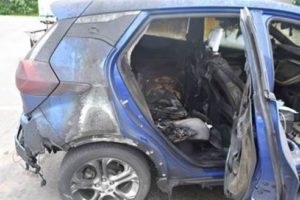
GM to repairers: Don’t leave Bolt EVs unattended indoors
By onAnnouncements | Business Practices | Repair Operations | Technology | Uncategorized
Repair shops that have Chevrolet Bolt EVs and EUVs awaiting or undergoing repairs should not leave them unattended indoors overnight, the automaker has advised.
The recommendations come after GM’s voluntary expansion of its Chevrolet Bolt recall to cover all electric Bolt vehicles, including the Bolt EV and the Bolt EUV, and mirror the advice given to owners. The recall is related to the vehicles’ high-voltage battery pack spontaneously catching fire, and includes those vehicles that may have been recalled for an earlier repair.
“We issued guidance to our Bolt EV owners in our press release. Service providers should follow these same guidelines,” a GM spokesman said.
Those recommendations, spelled out in the press release, advise that owners:
-
- Set their vehicle to a 90 percent state of charge limitation using Target Charge Level mode. Instructions on how to do this are available on (com/boltevrecall). If customers are unable to successfully make these changes, or do not feel comfortable making these changes, GM is asking them to visit their dealer to have these adjustments completed.
- Charge their vehicle more frequently and avoid depleting their battery below approximately 70 miles (113 kilometers) of remaining range, where possible.
- Park their vehicles outside immediately after charging and should not leave their vehicles charging indoors overnight.
“Just as we ask of our owners, we request that vehicles not be left unattended in a closed structure overnight,” the spokesman clarified.
According to GM, the issue may be related to defects in the manufacture of the battery packs by supplier LG. “In rare circumstances, the batteries supplied to GM for these vehicles may have two manufacturing defects — a torn anode tab and folded separator — present in the same battery cell, which increases the risk of fire,” the automaker said in a statement.
The power down procedures are made available via GM’s Service Information, which the automaker encourages all repairers to follow at all times.
Repairers that do not have a direct subscription to GM SI may use licensing partners to bring GM’s information into their tools. The main applications that would cover the majority of shops today include:
- AllData and AllData Advantage
- Mitchell Cloud Estimating
- CCC Repair Methods
Customers can visit www.chevy.com/boltevrecall or contact the Chevrolet EV Concierge 1-833-EVCHEVY (available Monday through Friday from 8 a.m.–midnight ET; Saturday and Sunday from noon–9 p.m. ET) or contact any Chevrolet EV dealer. Canadian customers can visit the Chevrolet Owner’s Centre (available in English and French) or contact a dealer.
According to the National Highway Traffic Safety Administration, the new recall affects an additional 59,392 2019-2022 model year vehicles not covered in recalls issued in November 2020 and July 2021. NHTSA said it is aware of one fire in a vehicle with the interim remedy, and three fires with the subsequent remedy.
NHTSA opened an investigation (PE 20-016) in October 2020, and continues to evaluate the recall remedies and reported incidents, including fires.
Vehicle owners can visit NHTSA.gov/recalls and enter their 17-digit vehicle identification number for more information on this recall. For more information on this recall, visit chevy.com/boltevrecall.
More information:
NHTSA Office of Defects Investigation document:
https://static.nhtsa.gov/odi/inv/2020/INOA-PE20016-7505.PDFDOT NHTSA ODI Document
Images:
Featured image: A 2019 Chevrolet Bolt EV owned by Vermont state legislator Tim Briglin caught fire on the night of July 1 while it was being charged in the owner’s driveway, according to Vermont State Police. Photo provided by the Vermont State Police.
UAW Local 5960 member Kimberly Fuhr inspects a Chevrolet Bolt EV during vehicle production on Thursday, May 6, 2021, at the General Motors Orion Assembly Plant in Orion Township, Michigan. (Steve Fecht/Chevrolet)
